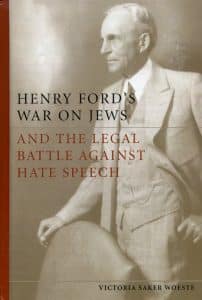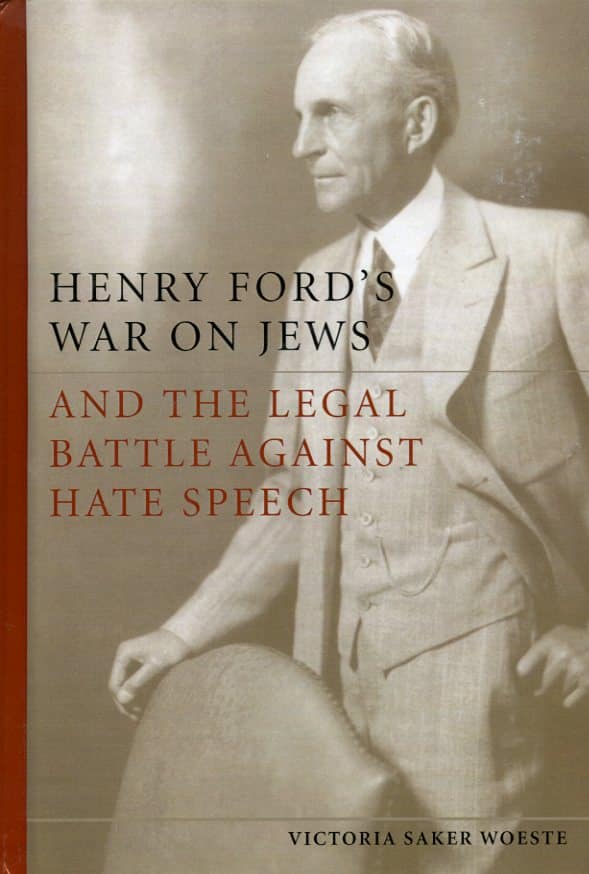 The term antisemitism almost immediately, and understandably, conjures up images of the Nazi state-sponsored persecution and murder of European Jews between 1933 and 1945. However, antisemitism is not only synonymous with the rise of the Nazi Party. The hatred of Jews – the basic definition of antisemitism – long preceded the Third Reich. As Victoria Saker Woeste demonstrates in Henry Ford’s War on Jews and the Legal Battle Against Hate Speech, antisemitism was also not only limited to Europe. In what historians have accurately labelled the “Tribal Twenties”, the United States of America, in the aftermath of World War I was gripped with racism. In fact, minority and immigrant demands for increased social, economic, and political equality coincided with the resurgence of the Ku Klux Klan during the “roaring twenties” (pg.6).
The term antisemitism almost immediately, and understandably, conjures up images of the Nazi state-sponsored persecution and murder of European Jews between 1933 and 1945. However, antisemitism is not only synonymous with the rise of the Nazi Party. The hatred of Jews – the basic definition of antisemitism – long preceded the Third Reich. As Victoria Saker Woeste demonstrates in Henry Ford’s War on Jews and the Legal Battle Against Hate Speech, antisemitism was also not only limited to Europe. In what historians have accurately labelled the “Tribal Twenties”, the United States of America, in the aftermath of World War I was gripped with racism. In fact, minority and immigrant demands for increased social, economic, and political equality coincided with the resurgence of the Ku Klux Klan during the “roaring twenties” (pg.6).
The US faced increased immigration in the early twentieth century that continued after World War I. Many foreigners arrived in America seeking the promise of prosperity through liberty and freedom. The nation emerged from First World War a victor and a rising world power. Domestically, Americans were moving away from rural areas to the more affluent cities in large numbers. This combined with the dramatic social, cultural, economic, and political changes taking place, the United States was becoming the world’s most modern society.
Henry Ford was a key public figure in America in the 1920s. He was popular, inextricably linked with economic prosperity and achieved folk-hero status. In 1919, he purchased and published The Dearborn Independent, which built a large readership by the mid-1920s, where he disguised his antisemitic beliefs as promoting his picturesque American life. For example, as the author points out, Ford simultaneously exploited modernity to make his fortune while blaming that very modernity on a supposed out-sized Jewish influence on America’s society and economy. (pg. 47).
Woeste attempts to balance the popular image of Henry Ford, the automobile manufacturer, purveyor of the assembly line, and all around American folk hero with Henry Ford the populist and antisemite who used The Dearborn Independent to promote an idealized, simplistic, and homogenized America to its largely rural readers. Ford used his position in American society, along with his newspaper, to promote his antisemitism by claiming Jews were undermining what he believed was the idyllic American society. The newspaper contrasted his image of national identity with all the classic antisemitic stereotypes, including Jewish cunning manipulation, concentration on power and money, and ties to socialism and Communism.
Using never-before-examined records, the book details Ford’s legal troubles throughout the 1920s related to antisemitic statements made in The Independent. Two lawyers and advocates for equality and human dignity, Louis Marshall and Aaron Sapiro, took issue with much of the material published in the newspaper. The author takes an interdisciplinary approach, combining history and the law, to explore rising antisemitism in America in the 1920s, group libel, and freedom of expression. However, despite having a common enemy in Henry Ford and The Dearborn Independent, Marshall and Sapiro were at odds with how to proceed, which reflected the Jewish community at large. By placing the trial within its social and political context, she is best able to demonstrate the historical value of Sapiro v. Ford. Woeste argues in her introduction that “Sapiro v. Ford was a significant trial with concerns that resonate overtime and go directly to the heart of how Americans perceive and understand themselves” (pg.1).
Marshall first encountered Ford in the aftermath of The Independent publishing ninety antisemitic articles over a nearly two-year period that uncovered the supposed connection between “International Jews” and world affairs. The Protocols of the Elders of Zion were central to the series in Ford’s newspaper where they were “adapted and Americanized”. That The Protocols were proven to be a forgery did not matter. They reflected Ford’s attitudes about Jews, and he was able to disseminate these beliefs to a nearly 700,000 person readership by the mid-1920s.
Ford’s second target, Sapiro was attacked far more directly and personally in The Independent, in a number of articles, for his work supporting US and Canadian farmers to establish cooperatives to help independent farmers compete with larger corporate enterprises. Given his background, it seems Ford should have been in favour of helping smaller farmers. Rather, he turned Sapiro’s work into an international Jewish conspiracy to undermine American society by invoking socialism.
Marshall wanted to stop Ford without giving him a larger platform to broadcast his antisemitism. Though protections for freedom of speech were not yet as robust in the 1920s as today, he did not believe the courts were the best avenue to confront Ford. Marshall reasoned the best way to combat hate speech was to pay no public attention to the speaker, giving the prejudicial ideas no oxygen. As the leader of the American Jewish Committee, he was ultimately concerned with the American Jewish community as a whole more than any degrading comments that were made towards individuals. He spent much of his adult life fighting for the rights and equality for Jewish citizens and newcomers. He feared that attacking a man with Ford’s prominence would backfire in the fight for Jewish civil rights and equality. Supporters of the automobile magnet may, in fact, see any attack against Ford as part of some international Jewish conspiracy to undermine US national identity.
Sapiro, on the other hand, went directly after Ford. Ford and The Independent directly attacked Sapiro’s character and reputation by claiming the latter was using manipulative and underhanded strategies to undermine the fortunes of American farmers and the capitalist system. Sapiro sued Ford for libel and sought one million dollars in reparations. Though this case involved antisemitic comments made against Sapiro, there was an implication that the content was aimed against an entire group. There was no law against group libel in Michigan, and the judge determined that any connection to antisemitism aimed at America’s Jews was not to be brought into the proceedings. This case was to exclusively be concerned with Ford’s disparaging remarks about Aaron Sapiro.
Using court transcripts and newspaper reports, Woeste thoroughly details the courtroom proceedings, and skillfully combines law and history to demonstrate the trial’s significance in US legal history. The key issues in the hearing were group versus individual libel, the question of race in American judicial proceedings, and freedom of speech. In addition, she shows that it was the courtroom drama, the unorthodox conduct of Ford’s legal team, and the anticipation of Henry Ford testifying in his own defence that garnered the attention of the American public. The public does enjoy court cases involving high profile people, and in 1920s America, there was arguably nobody more high profile than Henry Ford.
The episode ended in a mistrial. To avoid a second trial and the potential of having to pay a large settlement, Ford approached Marshall to assist in issuing an apology, something Marshall had sought since The Independent published its first antisemitic article. As Marshall did not agree with Sapiro’s lawsuit, arguing it would accomplish nothing for Jewish equality and civil rights, he agreed to help Ford. As Woeste writes, “Marshall believed that obtaining Ford’s apology at the expense of the lawsuit served both justice and the politics of Jewish civil rights activism” (pg. 289).
What made the apology interesting, as Woeste suggests, was that it was not written by Ford. Marshall himself penned it. The goal of getting Ford to apologize and stop the circulation of The International Jew was his top priority. This was about more than the reputation of one person, it was about the civil rights of an entire community. In Marshall’s mind, the trial involved Sapiro, but it was not only about him. It was clear, at the time, that the trial may have started as an individual’s battle against an antisemite, but quickly became about the Jewish community.
In the end, Marshall, Woeste writes, ultimately failed. Though the circulation of The International Jew was stopped, the apology was weak at best and a complete fabrication at worst; “[the apology] was a masterful work of evasion draped in apparent contrition” (pg. 271). Marshall’s intervention allowed Ford to deflect his responsibility for The Dearborn Independent’s antisemitic rhetoric by placing the blame almost entirely on the publication’s staff. Ford likely viewed this behind-the-scenes negotiation as a victory. He was not held responsible for comments made toward Sapiro, and he was not held financially liable.
This book is thoroughly researched and well-written making it accessible to readers interested in both the law and history. The way in which Woeste weaves together the law within its historical context makes the study an important addition to history of race relations in America in the 1920s, the evolution of free expression, and libel law. Racism and discrimination were nothing new in America. Ford’s antisemitism did not exist in a vacuum. This study adds to historical understanding of how his racism was woven into the fabric of American society in the post-World War I period. As Woeste argues, Ford believed himself to be a reflection of US national identity. As society changed and modernized, he blamed some nefarious international cabal of Jewish cosmopolitan influence for what he saw was the degradation of the American heartland. The volume establishes that law and society are not mutually exclusive. Rather they are counterparts that reflect and influence each other.



